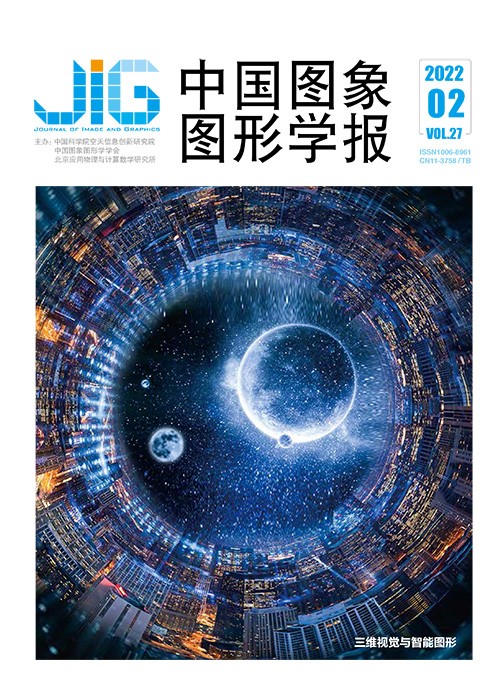
三维点云配准方法研究进展
摘 要
点云是一种3维表示方式,在广泛应用的同时产生了对点云处理的诸多挑战。其中,点云配准是一项非常值得研究的工作。点云配准旨在将多个点云正确配准到同一个坐标系下,形成更完整的点云。点云配准要应对点云非结构化、不均匀和噪声等干扰,要以更短的时间消耗达到更高的精度,时间消耗和精度往往是矛盾的,但在一定程度上优化是有可能的。点云配准广泛应用于3维重建、参数评估、定位和姿态估计等领域,在自动驾驶、机器人和增强现实等新兴应用上也有点云配准技术的参与。为此,研究者开发了多样巧妙的点云配准方法。本文梳理了一些比较有代表性的点云配准方法并进行分类总结,对比相关工作,尽量覆盖点云配准的各种形式,并对一些方法的细节加以分析介绍。将现有方法归纳为非学习方法和基于学习的方法进行分析。非学习方法分为经典方法和基于特征的方法;基于学习的方法分为结合了非学习方法的部分学习方法和直接的端到端学习方法。本文分别介绍了各类方法的典型算法,并对比总结算法特性,展望了点云配准技术的未来研究方向。
关键词
Review on 3D point cloud registration method
Li Jianwei, Zhan Jiawang(College of Physics and Information Engineering, Fuzhou University, Fuzhou 350116, China) Abstract
As a 3D representation, point cloud is widely used and brings many challenges to point cloud processing. One of the tasks worth studying is point cloud registration that aims to register multiple point clouds correctly to the same coordinate and form a more complete point cloud. Point cloud registration should deal with the unstructured, uneven, noise, and other interference of the point cloud. It needs a shorter time consumption and achieves a higher accuracy. However, time consumption and precision are often contradictory, but it is optimized to a certain extent is possible. Point cloud registration is widely used in fields such as 3D reconstruction, parameter evaluation, positioning, and posture estimation. Autonomous driving, robotics, augmented reality, and others applications also involve the cloud registration technology. For this reason, various ingenious point cloud registration methods have been developed by researchers. In this paper, several representative point cloud registration methods are sorted out and summarized as a review. Compared with related work, this paper tries to cover various forms of point cloud registration and analyzes the details of several methods. It summarizes the existing methods into nonlearning methods and learning-based methods. Nonlearning methods are divided into classical methods and feature-based methods. Among them, the classic methods include iterative closest point and its variants, normal distributions transform and its variants, and 4-points congruent sets and its variants. Iterative closest point and normal distributions transform and their variants are classical fine registration methods and can achieve a high accuracy, but need a good initial pose. The 4-points congruent sets and its variants are classical coarse registration methods, do not need an initial pose, and can be used as the initial pose for fine registration after this coarse registration. For feature based algorithms, the methods of feature detection, feature description, and feature matching are introduced. They are the main process of a typical point cloud registration method in addition to other steps such as preprocessing of point cloud and calculation and verification of transformation matrix. The features are divided into point-based features, line-based features, surface-based features, and texture-based features. For different features, feature detection, description, and matching are also different, but none of them need an initial position. In addition to registration, these features can also be used for point cloud segmentation, recognition, and other tasks. Similarly, learning-based methods are subdivided into two types:partial learning methods that combine nonlearning components and purely end-to-end learning methods. The partial learning method replaces several components in the nonlearning method with learning-based components and exerts the high speed and high reliability of the learning method, which can bring great improvement to the nonlearning method. This method can also use several learning components designed for other tasks and provide learning components designed for registration tasks for other tasks; thus, it has a high flexibility. Many of these methods are similar to feature-based nonlearning methods and are feature based. However, several methods learn to segment point clouds and then use iterative closest point or normal distributions transform for registration. These partial learning methods have great flexibility, but the data required by partial learning methods are not easy to obtain, and verifying the learning results of partial learning is not easy. The end-to-end learning methods are more convenient to learn, its training data are easier to obtain, and the learning results are easier to verify. The end-to-end method also has a great advantage in speed, which can make full use of the computing power of the graphics processing unit(GPU). Nonlearning methods have lower hardware requirements, are easier to implement, and do not require training. They may not have an advantage in computing speed under the same registration performance, whereas learning-based methods can learn more advanced features in the point cloud, which is very helpful for improving the registration performance but depends on the diversity of the data set and the more advanced deep learning structure. The details of several typical algorithms for each method are introduced, and then the characteristics of these algorithms are compared and summarized. The performance of point cloud registration algorithms is constantly improving, but more point cloud application scenarios also entail higher requirements for point cloud registration, such as the requirements for real-time performance and the effectiveness of noise and lack or repetitive features, and robustness when dealing with unstable point clouds of multiple moving objects. Point cloud registration technology is still a worthy research direction. Point cloud registration technology will inevitably continue to make breakthroughs in speed, precision, and accuracy, and serve more applications.
Keywords
|



 中国图象图形学报 │ 京ICP备05080539号-4 │ 本系统由
中国图象图形学报 │ 京ICP备05080539号-4 │ 本系统由